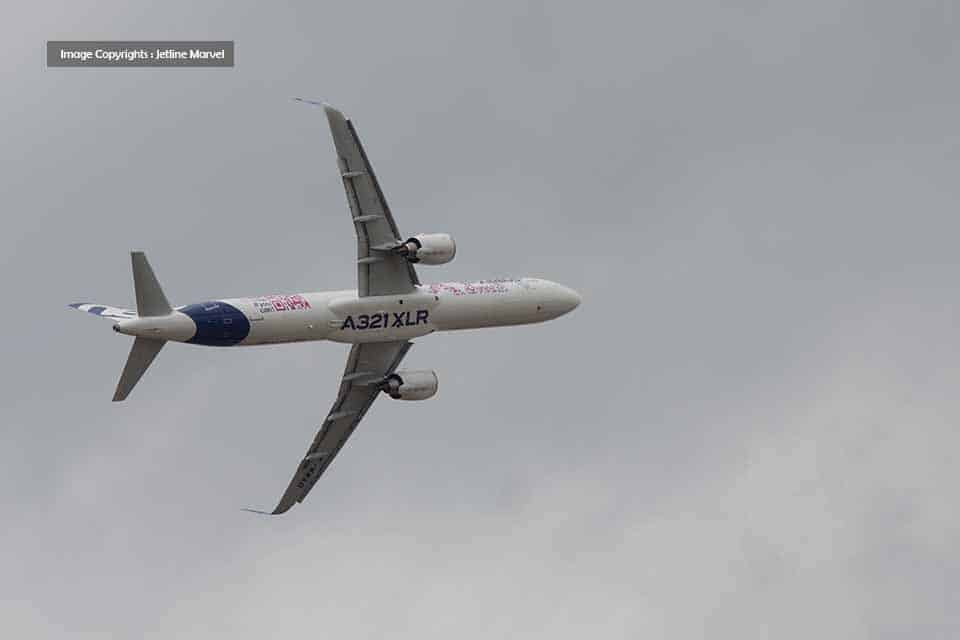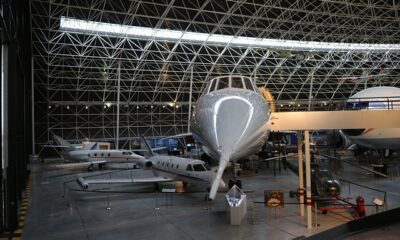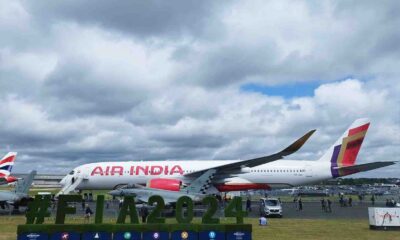Aerospace
5 latest innovative equipments by Airbus.

1. “Lining up” for innovation: A new non-destructive testing tool takes off with the Airbus A350 XWB
An easy-to-use testing tool for inspecting the composite airframe of Airbus’ popular A350 XWB jetliner has become a commercial success itself, with key airline customers ordering the device to support their daily operations.
Named the Line Tool, this ultrasound system is used to inspect an A350 in the event of impact shocks. These can occur at airports if, for example, catering trucks, baggage loaders or other vehicles make hard contact with an aircraft.
Easily portable in a small-sized suitcase, the Line Tool offers a simple and cost-effective solution for on-site inspections, and can be utilised by airline personnel who are not experts in composite materials. In addition, Line Tool employs the non-destructive testing (NDT) principle that allows damage assessments to be made without affecting the fuselage or wing area that is examined.
“The Line Tool delivers an automatic diagnosis, which means that airlines can carry out their own tests straight away,” explained Patrick Métayer, the head of non-destructive testing at Airbus.
2.Airbus’ innovative cable tie solution transitions from the shop floor to the world
A patented, paper-based Airbus solution that improves the process for installing cables and wires throughout an aircraft is now going global, underscoring the company’s continuing role as an innovation leader.
The idea began with Marc Bennion, a long-time Airbus employee working at the aircraft manufacturer’s Broughton, UK facility – which is responsible for assembling wings for all Airbus commercial jetliners, including the new-generation A350 XWB.
Bennion was fitting wiring to a wing when he realised that using pliers to snip off the plastic ties – which keep the cables organised – sometimes caused accidental damage. As even very minor damage results in the replacement of an entire cable, this was increasing costs and time spent, as well as causing frustration for Bennion and his colleagues.
As an alternative, Bennion proposed the idea of paper ties that could be torn off by hand instead. After experiments with several designs, a prototype was approved and subsequently patented by Airbus UK. “Marc’s name appears on the patent alongside Airbus,” said project leader Maud Didnee. “It proves that every idea matters and that innovation can be about simple ways of making a routine job easier.”
3.Virtual solutions provide real benefits for Airbus’ Beluga XL development.

As Airbus continues development of its next-generation oversize cargo transporter – the Beluga XL – the company has devised innovative solutions that are advancing this particular programme and will be used to benefit others in the future.
Among the innovation solutions is a new method for systems installation design that leverages 3D technology and virtual reality. As the existing A330 Family digital mock-up (DMU) only included the aircraft’s structural definition in some sections and not its systems, François Rouyre – who is Airbus’ head of DMU and structure, systems and cabin integration – had an interesting idea. “We decided to scan the physical aircraft with its system installation to check the DMU and give us complete visibility on its systems.”
Rouyre used a 3D laser scanner to produce a highly-detailed, 360-degree image. As this large file would be difficult to manipulate in computer-aided design software, he added it into the DMU in virtual reality – inside a full-scale virtual reality room so designers could then work on it directly.
“You can design about 20 metres of electrical bundles in an hour with virtual reality, whereas for CAD software, one metre takes four hours,” Rouyre added. “This method could be used by other programmes to quickly change a definition, answer a concession or a design query note.”
4. Airbus innovation effectively streamlines the repair process for fibre optic cables
A transnational, transfunctional Airbus team has been honoured for developing a highly-efficient new method to repair fibre optic cables, which are used extensively across the company’s product line of modern commercial jetliners.
Lighter than traditional metallic wiring and offering much higher bandwidths, fibre optic cables are applied throughout an aircraft – integrated in taxi aid cameras, head-up displays, in-flight entertainment, cockpit systems and other key components. However, if non-conformities were discovered in a cable during its installation, making the necessary repairs was a costly and time-consuming process.
Project co-leader Laetitia Mennebeuf, a fibre optics specialist from Airbus’ Systems Engineering department, explained the issue at hand: “Before, if damage was found, the entire cable and surrounding harnesses needed to be removed so that the repair could be performed in a shop outside of the aircraft. This took 10 hours to do and in removing the harness, other cables and wiring could get damaged.”
She added: “One of the more common non-conformities concerns the contacts at the two ends of a cable. If the contacts were deficient, they had to be cleaned and polished or remanufactured at the shop floor laboratory.”
“Working with our supplier, AVOptic, we developed new, portable tools that re-polish the contacts,” explained fellow project co-leader Nadège Brunaud-Martinerie, an engineer from Airbus’ Manufacturing Engineering department. The process was introduced at Airbus facilities through special “awareness sessions.”
“Because they’re portable – and battery-powered – the new tools can be brought on board the aircraft and repairs made without disturbing the other installers,” she continued. “We use the same processes and get the same results and quality as before, but by not having to remove entire cables and harnesses, repair time is cut from 10 hours to two hours.”
5.“Smart glasses” show the future of Airbus’ innovative aircraft cabins
Airbus is providing immersive experiences with the company’s passenger cabins of tomorrow – leveraging “smart glasses” that integrate state-of-the-art 3D data technology for virtual, interactive tours of future aircraft interiors and their advanced functionalities.
“Visits” with smart glasses – developed by Airbus virtual reality experts together with the company’s cabin marketing team – already are proving to be a major success with customers during trips to Airbus facilities, as well as with trade show attendees.
At the heart of the smart glasses is a high-resolution smartphone, which features a special Airbus app. The smartphone is clipped to a headset and once the app is launched, the virtual reality experience can begin. By focusing on a specific point, the user decides where to go – choosing from different aircraft, first or business class, galley concepts and more.
Inside the virtual cabin, visitors can pull out galley units, take a closer look at the lavatory or zoom in on details. Additional apps offer the possibility to compare seat colours, mood lighting designs and other options. Move your head up, down, or to the side and your view moves along the virtual cabin wall accordingly.
While the customer is exploring the cabin, an Airbus representative can follow his or her path on a tablet. “This way, we can answer questions directly and point out differences between module versions, for example,” said Airbus’ Dieter Kasch, who last year – along with his virtual reality team – brought the smart glasses to maturity during a period of only three months.
Source : Airbus press
Liked it ..?
Share with your friends and family

Aerospace
When Ratan Tata was denied entry to the airfield at the Aero India show, he waited

During our visit to Aero India 2019, we had the unexpected opportunity to see Ratan Tata at the event, which was a thrilling moment for us. However, there was a surprising hiccup when the security staff didn’t allow him to enter due to a lack of a security pass.
Despite this, he remained calm and patiently waited for about 20 minutes until a member of the Tata team brought him the required pass, after which he calmly proceeded inside. It was a humbling sight, showcasing his composed demeanor even in such situations.
Ratan Tata ji is not only a renowned industrialist but also a trained pilot, holding a pilot’s license. In 2007, he became the first Indian civilian to fly the F-16 Falcon during the Aero India show in Bangalore—a proud moment for the nation.
His passion for aviation extended beyond flying, as he played a key role in shaping India’s aerospace industry. Under his leadership, Tata ventured into manufacturing and maintaining aerospace components while upholding its legacy of quality. Notably, Tata’s collaboration with Airbus to develop and manufacture the C295 aircraft is a testament to its growing influence in the sector.
-

 Aviation2 months ago
Aviation2 months agoBoeing confirms 797: A New Era for Mid-Size Aircraft
-

 Aviation1 month ago
Aviation1 month agoMicrosoft Flight Simulator Raises $3 Million to Bring Back the An-225 Mriya
-

 Aviation2 months ago
Aviation2 months agoLockheed and Tata Team Up to Build C-130J MRO Facility in India
-

 Tech2 months ago
Tech2 months agoChina Developing Jet to Travel Anywhere in Two Hours
-

 Airlines2 months ago
Airlines2 months agoQantas Engineers Stage Walkout Over Cost of Living Concerns
-

 Airlines1 month ago
Airlines1 month agoQatar Citizens Can Travel to the United States Without a Visa
-

 Aviation2 months ago
Aviation2 months agoBoeing Offers 25% Pay Increase & Promise to Build Next Plane in Seattle
-

 Airlines2 months ago
Airlines2 months agoIndian Government Approves Air India and Vistara Merger








